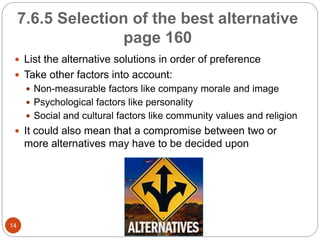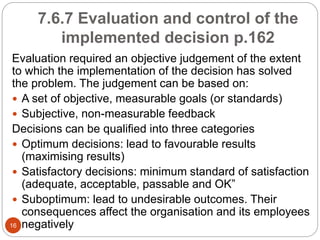N6 Communication - Problem solving for N6 students at TVET Colleges
- 1. Mod 2: Problem solving and decision making (Chapter 7), p.152-164 1
- 2. 2
- 3. 7.1 Definitions Problem: a “doubtful or difficult question”. It can also be a situation where some relevant facts are known and others are unknown. Problem solving: involves a procedure which includes identifying matters that need to be improved or changed, and making a series of decisions aimed at improving or changing such matters. Decision: is defined as the “settlement of a question, formal judgement, making up one’s mind”. Decision making: a deliberate act of selection (or choice) of an alternative from a set of competing alternatives, in the hope that the chosen alternative will accomplish certain goals. 3
- 4. 7.2 Interdependence of concepts Problem solving and decision making – these two concepts are interdependent. 4
- 5. 7.3 Role of comm – factors which contribute to sensible decisions N4: Can you remember? 1)Frame of reference 2) Ability to reason logically 3) Personality 4) Emotions 5
- 6. 7.3 Role of comm – factors which contribute to sensible decisions Other factors: (p.152) 1. Frame of reference: adequacy of available information 2. Frame of reference and logical reasoning: Intelligence, education and experience of the decision-maker 3. Personality traits of the decision-maker 4. Personality: insight and intuition of the decision maker 5. Emotional factors 6
- 7. 7.4 Unpredictable and uncontrollable factors Unexpected problems can develop into opportunities in a completely unexpected and uncontrolled manner. Correct decisions are sometimes made by mere coincidence The demand on personalised number plates increased after New York State decided to charge an additional levy on all personalised vehicle number plates. Instead of decreasing the amount of plates, it created a demand for these items.7
- 8. 7.5 General decision making process 1. (Acknowledge that a problem exists) 2. Identify and define the problem 3. Investigate the problem 4. Formulate the exact problem in writing 5. Develop alternative solutions 6. Evaluate the alternative solutions 7. Select the best alternative 8. Implement the selected alternative/selection 9. Evaluate and control the implemented decision 8
- 9. 7.6.1 Identifying and defining the problem (p.155) 1. Acknowledge that a problem exists; symptoms include: Previous pattern of action or performance is interrupted or broken Expectations are not realised Complaints are received Excessive rivalry could become evident 2. Identify and define the problem Identity Location (where?) Magnitude Timing 3. Investigate the problem Collect and analyse data Determine the origin of problem, people involved, any contributing factors Determine true magnitude of problem and influence on other situations 9
- 10. 7.6.2 Formulating the exact problem in writing p.158 You gain the following when formulating the exact problem in writing: It forces one to think about and formulate the problem logically, objectively and systematically It helps one to understand the problem better It could serve as a framework for further action, as well as a measure of control. 10
- 11. 7.6.3 Developing alternative solutions p. 158 Theoretical aspects Applied to example Standard, obvious solution Creative solution Relying on expertise Drawing on past solutions Brainstorming session Ask the taxi company to change their schedule Institute own shuttle service Higher productivity would neutralise cost of shuttle service Discussions with taxi owners 6 months ago led to temporary solution Allow employees to discover that café stop wastes time and how much they can gain by cutting it out11
- 12. 7.6.4 Evaluation of alternative solutions p.159 Thorough investigation into each alternative solution that has been proposed Proposed solution should enable the organisation to realise its objectives. The proposed solution should be affordable, in terms of the available 1) Financial resources 2) Manpower resources The proposed solution should be acceptable to Those who would be affected by its implementation Those who are required to implement it Each alternative should be evaluated in terms of its consequences for the organisation Each alternative should be judged in terms of which problem it would solve, as well as which further problem it might cause.12
- 13. 7.6.4 Evaluation of alternative solutions p.159 (continued) The risk factor of each alternatives should be considered The proposed solution should be an alternative which could improve the current situation; not one which would have worked in the past Various techniques can be applied during the process of evaluation: Experimentation Simulation Using Knowledge Experience Objective judgement 13
- 14. 7.6.5 Selection of the best alternative page 160 List the alternative solutions in order of preference Take other factors into account: Non-measurable factors like company morale and image Psychological factors like personality Social and cultural factors like community values and religion It could also mean that a compromise between two or more alternatives may have to be decided upon 14
- 15. 7.6.6 Implementation of the selected alternative/decision p.161 A decision can only be effective if it leads to action. Once selected the implementation procedure must be explained. Employees may have to be persuaded to accept it. Tasks and resources have to be allocated and a means of monitoring it determined. The following aspects must be considered before implementing the decision: A realistic budget A realistic timetable Tasks should be delegated appropriately Regular feedback Means of detecting and counteracting possible problems15
- 16. 7.6.7 Evaluation and control of the implemented decision p.162 Evaluation required an objective judgement of the extent to which the implementation of the decision has solved the problem. The judgement can be based on: A set of objective, measurable goals (or standards) Subjective, non-measurable feedback Decisions can be qualified into three categories Optimum decisions: lead to favourable results (maximising results) Satisfactory decisions: minimum standard of satisfaction (adequate, acceptable, passable and OK” Suboptimum: lead to undesirable outcomes. Their consequences affect the organisation and its employees negatively16
- 17. Notes Although the judgement of a decision must be objective, economic as well as non-economic criteria should be taken into account during the evaluation process. A business venture could be an economic success, but become a major responsibility which has a negative influence on one’s personal life. In addition to profit, factors such as personal satisfaction, absence of stress and social good should all be considered when evaluating a decision. 17
- 18. 18


















